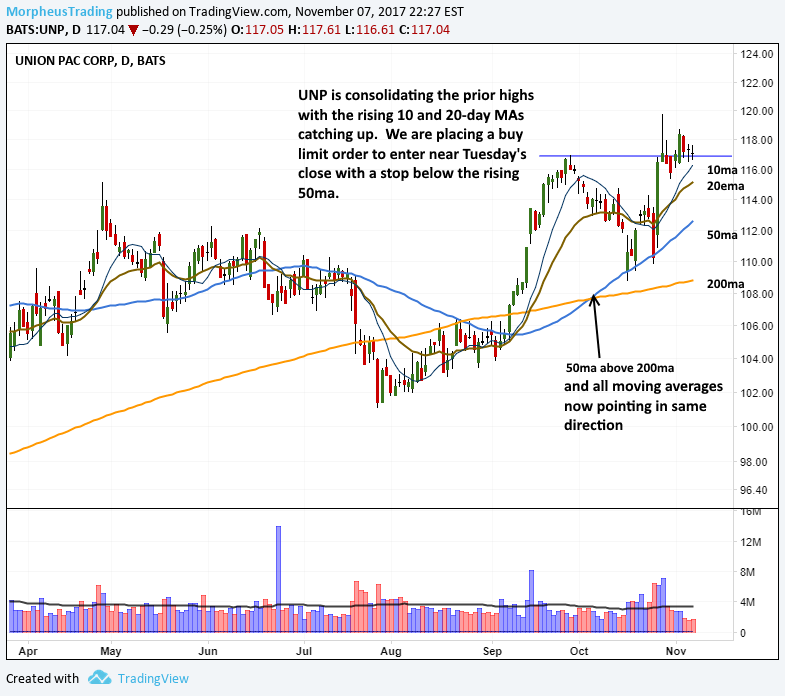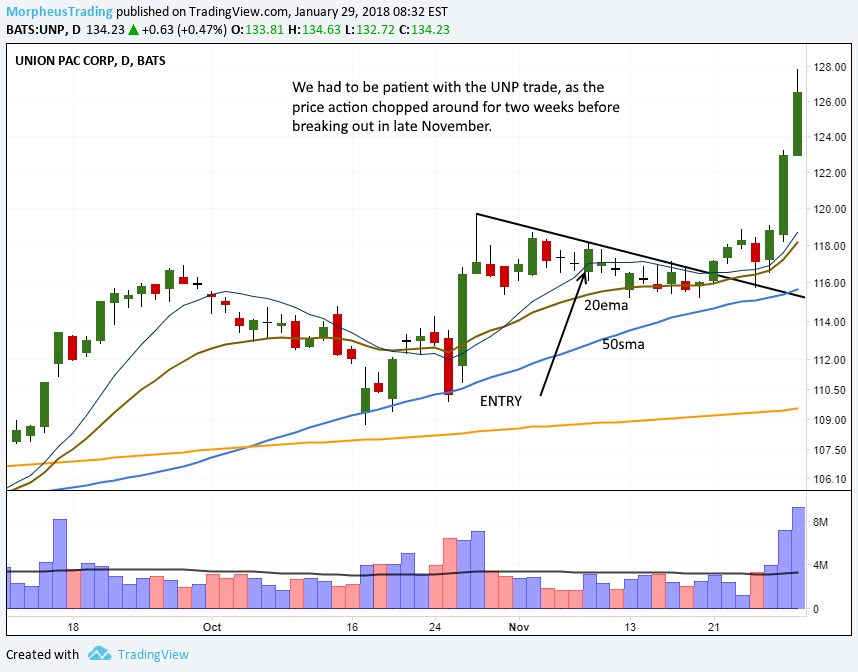We recently bought Union Pacific (NYSE:UNP) as a breakout trade, held it for ten weeks, then sold for a +20% gain ahead of earnings. Continue reading to find out why we picked this stock for buy entry, and how we managed this trade for maximum profitability with low risk.
The chart pattern of transportation stock Union Pacific ($UNP) first caught our attention in late October 2017.
At that time, the price of $UNP surged sharply higher, on heavier than average volume, after bouncing off key support of its 50-day moving average (50-day MA).
The 50-day MA had also crossed above the 200-day MA, following six months of basing action between $102 and $114.
But although the 50-day MA crossing above the 200-day MA is a bullish signal, it should not be used as an actual entry point because it’s too obvious.
When buy signals are too obvious to the average stock market speculator, a short-term pullback/shakeout usually follows.
The moving averages pointed to a clear buy signal, but we needed to wait for a low-risk entry point on the pullback.
Buying The Pullback For Low-Risk Entry
On November 7, we listed $UNP as an official buy setup in The Wagner Daily.
Our plan was to buy Union Pacific shares with a limit order, on a pullback to near the rising 10-day MA.
If the 10-day MA failed to hold on a pullback, the 20-day exponential moving average (20-day EMA) was providing more support just below.
The chart below (taken directly from that day’s report) shows the bullish trade setup at the time:

As expected, $UNP pulled back and triggered our buy entry at $116.67 the next day.
The stock initially failed to hold above its 10-day MA following our buy entry.
However, $UNP found support after a few brief (and typical) shakeouts below its 20-day EMA.
Union Pacific then consolidated in a tight, sideways range for a week before breaking out to fresh highs in late November (on increasing volume).
The buy entry, consolidation, and breakout is clearly displayed on the chart below:

Riding The Bullish Momentum
$UNP was an easy position to hold after the breakout because the uptrend that followed was smooth and steady.
The best breakout-induced uptrends hold above their 10-day MAs after the bullish momentum gets under way.
Looking at the chart below, notice that $UNP held firmly above its 10-day MA throughout the entire advance:

As long as an uptrending stock remains above its 10-day MA, there is typically no reason to sell — let the winner ride the bullish momentum to maximize your gain.
But because the quarterly earnings report was scheduled for January 25, we eventually tightened our protective stop order on two-thirds of the position size to lock in profits.
That sell stop order triggered on January 23, enabling Wagner Daily subscribers to lock in a solid 20% gain on most of the shares.
We initially planned to hold the remaining third of the winning position into earnings, but later felt the stock was too extended to take the risk.
As such, we sold the remaining shares on the January 24 open and secured another 20% gain on the rest of position.
Selling Union Pacific ahead of its earnings was a good move because $UNP opened about 6% lower on January 25 (a little luck never hurts).
Managing Winners Into Earnings
With our style of stock trading, which combines swing and position trading, we usually aim to sell into strength when there is an extended rally ahead of an earnings report.
This is especially true when it’s a well-known large cap stock like $UNP.
Conversely, if a small to mid-cap stock is breaking out from a first stage base and not extended on the monthly chart, we are a bit more aggressive with holding the position.
In this case, we prefer to sell partial shares into strength, then hold the remaining shares through earnings — but only IF overall market conditions are strong.
Regardless, there is no “one size fits all” solution to the question of whether to hold a stock through earnings.
Each situation is unique and a stock’s reaction to earnings is always a craps shoot.
